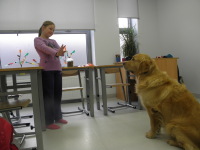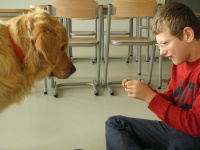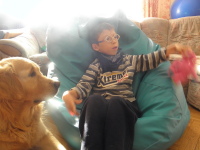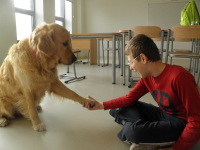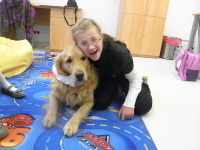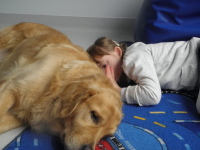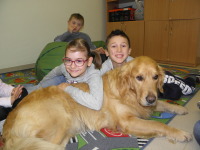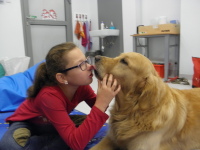Dog therapy
Dog therapy is a method of supporting rehabilitation and therapy, in which a properly selected and trained dog plays an important role. This method is based on the assumption that the presence of a dog will strengthen the motivation of the participant to achieve the adopted rehabilitation or therapeutic goals.
An inseparable element of the dog-therapy program should also be education on shaping the correct attitudes of people towards dogs and expanding knowledge about dog behavior. Both adults and children can participate in dog therapy classes. The course and nature of the meetings depends on the type of difficulties that participants have to face.
In the School Complex named after Brother Alojzy Kosiba as part of dog therapy, therapeutic and rehabilitation classes are conducted. Therapeutic classes are designed for children who, for various reasons, are afraid of dogs. They are designed to reduce resistance to contact with the dog, and regular meetings give children the opportunity to "get used to" its presence.
Work within the framework of therapeutic classes proceeds in two ways. On the one hand, using the behavioral method, the "distance" between the child and the dog is reduced, both in the literal – physical and symbolic sense – children learn to be and function freely in the presence of the dog. At the same time, the cognitive method is used – gaining knowledge about the behavior of a dog allows for a better understanding of its behavior and, above all, allows you to control contact.
Dog therapy can also be used as a method of work as part of rehabilitation classes. Using the tools characteristic of this method, you can implement any work plan. The dog itself and the activities associated with it provide a huge amount of sensory stimuli, which are used in working with children with profound mental disabilities. Direct, physical contact with the dog gives the opportunity to stimulate and regulate the sense of touch – with the help of different parts of the body, children touch the warm and soft coat, wet tongue, rough paw, etc.
Meeting with a dog is also a great opportunity to get to know a variety of sounds, i.e. balls of dry food falling into a metal or plastic bowl, munching the dog while eating, munching while drinking water, barking, purring, growling (which, contrary to appearances, children love!), as well as the sounds of dog toys. Many elements of tactile stimulation can be used in the process of shaping the sense of one's own body. These are exercises involving stroking the dog with the help of various parts of the body, but also, for example, an exercise in which children have the task of crawling under the dog. This task can also be an element of shaping spatial relations – many things (e.g. pass or put a bowl) can be done "under", "over", "behind" the dog. Very often, the plans of rehabilitation classes include goals related to the improvement of school skills, which can also be successfully implemented as part of dog therapy. By feeding a dog using colored bowls, children learn the names of colors, pouring the right amount of crisps into bowls, they can perform mathematical operations, practice writing and reading, creating labels and assigning them to the appropriate parts of the dog's body. Getting to know and giving commands to your dog is an excellent opportunity to train your memory. During dog therapy classes, children practice and improve communication skills.
Non-speaking people, on the one hand, can effectively communicate with the dog using gestures, which gives them a sense of agency and brings a lot of satisfaction, but more importantly, they have another opportunity to practice communication using alternative forms of communication, e.g. PCS.
Regardless of the goals that are achieved as part of dog therapy classes, there is one most important rule that should be followed when choosing this method. Dog therapy is a suitable method of work only for people who LIKE DOGS. These activities are not meant to involve forcing children to come into contact with the dog. Both among adults and among children we meet people who simply do not like dogs and this should be respected. For most children, however, the dog is a strong "motivator" to work and effort and a wonderful, understanding and patient companion.

